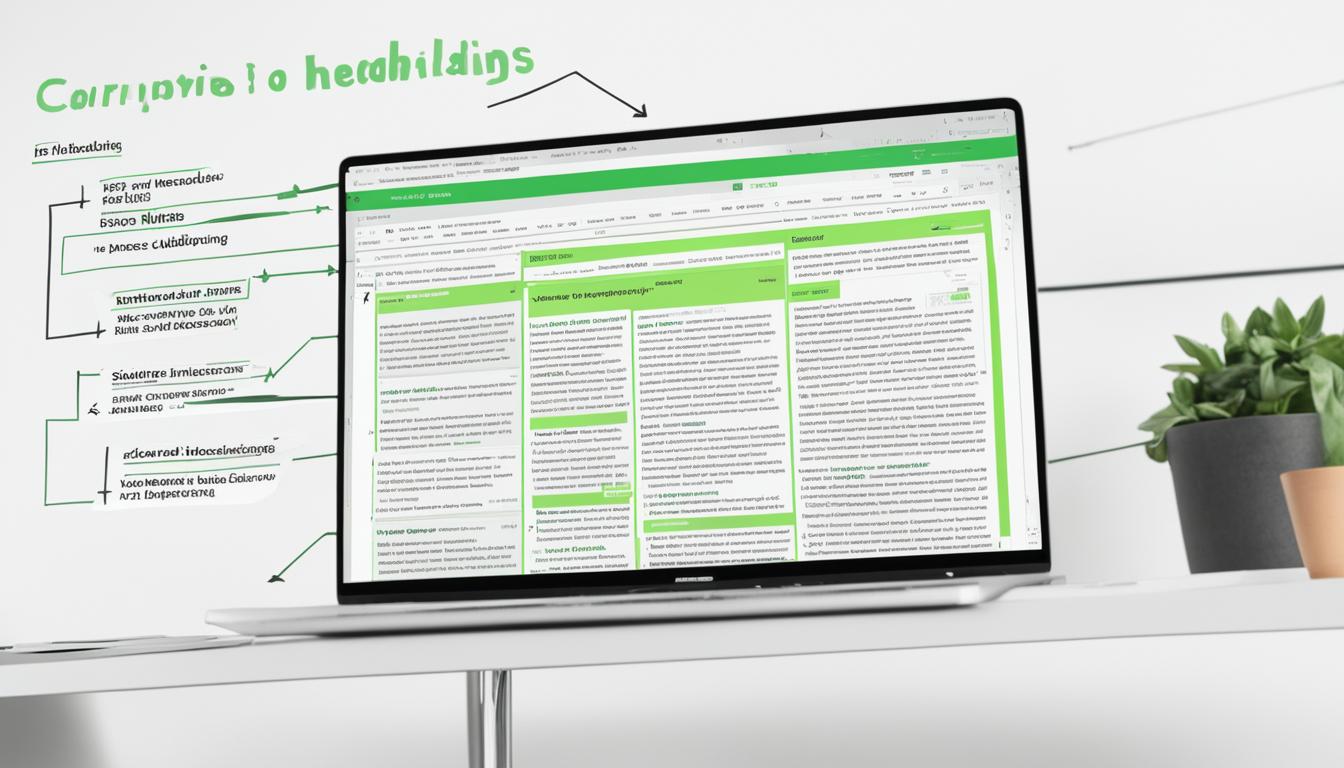Growing your online store can be challenging, but with the right strategies, you can optimize your e-commerce site to rank higher in search engines and attract more customers. That’s where SEO writing for e-commerce sites comes in. When you prioritize search engine optimization, you can improve your online store’s visibility and increase sales.
SEO writing for e-commerce sites involves various techniques and practices that aim to enhance your site’s organic rankings. From keyword research to optimizing on-page elements, every step counts towards creating an SEO-friendly online store that stands out in the crowded digital market.
By implementing effective SEO strategies, such as optimizing product descriptions and category pages, creating compelling content, and focusing on metadata optimization, you can make your e-commerce site more discoverable and user-friendly. Additionally, paying attention to SEO for your online retail blog and optimizing product pages can further boost your visibility and attract potential customers.
In this article, I will delve into the world of SEO writing for e-commerce sites, providing you with valuable insights on how to optimize your online store and drive more organic traffic. Get ready to learn about keyword research, e-commerce site architecture, creating SEO-friendly content, optimizing on-page elements, and measuring your SEO success.
Key Takeaways:
- SEO writing for e-commerce sites improves organic rankings and visibility in search engines.
- Keywords play a crucial role in optimizing e-commerce sites.
- An optimized site architecture enhances crawlability and user experience.
- Quality content attracts backlinks and improves domain authority.
- On-page elements, such as title tags and meta descriptions, should be optimized with relevant keywords.
Keyword Research for E-commerce SEO
Keyword research is an essential aspect of any successful e-commerce SEO strategy. As an SEO professional, I understand the importance of finding the right keywords that people use to search for products online. By selecting the most relevant keywords, e-commerce websites can optimize their product and category pages to increase visibility and drive organic traffic.
So, how do we conduct effective keyword research for e-commerce SEO? Well, there are several methods and tools that can help us uncover valuable keywords that align with our target audience. Let’s take a closer look:
Utilizing Keyword Research Tools
One way to find relevant keywords is by using keyword research tools such as Semrush’s Keyword Magic Tool. These tools provide valuable insights into search volume, keyword difficulty, and related terms, helping us identify profitable keywords for our e-commerce site. By understanding the search volume and keyword difficulty, we can prioritize keywords that offer the best opportunity for ranking and driving targeted traffic.
Exploring Google Autocomplete and Related Searches
Another effective method is to leverage Google’s autocomplete and related searches feature. By typing in relevant search queries on Google, we can gather insights into popular search terms and phrases used by our target audience. This not only helps us discover new keywords but also provides valuable context and understanding of buyer intent.
Utilizing Amazon’s Autocomplete Feature
Considering the significant influence of Amazon in the world of e-commerce, utilizing Amazon’s autocomplete feature can be a goldmine for keyword research. By entering relevant product queries on Amazon’s search bar, we can uncover valuable keywords that are specific to our niche. This allows us to optimize our e-commerce site for long-tail keywords that have a higher chance of conversion.
Browsing Relevant Subreddits
Reddit is a treasure trove of valuable information and insights, making it an excellent resource for keyword research. By exploring subreddits related to our product or industry, we can discover the language and terminology used by our target audience. This helps us identify relevant keywords and understand their buyer intent.
Conducting Competitor Research
Lastly, analyzing our competitors’ keywords can provide valuable insights into the keywords they are targeting and their search volume. By using tools like Semrush, Ahrefs, or Moz, we can identify the keywords our competitors are ranking for and assess their difficulty. This allows us to identify untapped keyword opportunities and refine our own keyword strategy.
By combining these methods and utilizing various keyword research tools, we can develop a comprehensive keyword research strategy for our e-commerce SEO campaign. This enables us to optimize our product and category pages with the most relevant and profitable keywords, increasing our chances of driving targeted organic traffic and boosting sales.
Benefits of Keyword Research for E-commerce SEO
| Benefits | Description |
|---|---|
| Improved Search Visibility | Selecting the right keywords helps improve search rankings and visibility in search engines, driving organic traffic to our e-commerce site. |
| Higher Conversion Rates | By targeting keywords that align with buyer intent, we can attract more qualified leads and improve our chances of converting them into customers. |
| Competitive Advantage | Understanding which keywords our competitors are targeting gives us a competitive edge, allowing us to refine our SEO strategy and outperform them in search rankings. |
| Optimized Product Pages | Keyword research helps us optimize our product pages with highly relevant keywords, leading to increased visibility and sales for specific products. |
| Improved ROI | By focusing on keywords with high search volume and low competition, we can drive targeted organic traffic to our site, resulting in a higher return on investment. |
Optimizing E-commerce Site Architecture

Site architecture is a critical aspect of e-commerce SEO that affects search engine visibility and user experience. It encompasses the organization of pages within the site, including navigation, URL structure, internal linking, and site speed. By optimizing site architecture, you can ensure that search engines can easily crawl and discover all product and category pages, improve usability for visitors, and distribute ranking strength effectively throughout the site.
When it comes to improving site architecture, there are several important considerations:
Navigation
Effective navigation is crucial for both search engines and users to find their way around your e-commerce site. Make sure to organize your site in a logical and intuitive manner. Ideally, users should be able to reach any product or category page from the homepage within just a few clicks. This helps search engines understand the hierarchy and importance of different pages on your site, improving their visibility in search results.
URL Structure
Customizing your URLs with relevant keywords can improve your site’s visibility and search engine rankings. When creating URLs for your e-commerce pages, consider including descriptive keywords that accurately represent the content of the page. This not only helps search engines understand the context of the page but also makes it more appealing and informative to users.
Internal Linking
Internal linking is the practice of linking relevant pages within your site. This helps search engines discover and navigate through your content more easily while also distributing ranking strength throughout your site. When creating internal links, use anchor text that includes relevant keywords. Additionally, consider implementing a breadcrumb navigation system to further enhance user experience and site navigation.
Site Speed
Site speed is a crucial factor in both SEO and user experience. A fast-loading website not only improves search engine rankings but also reduces bounce rates and improves conversions. To optimize site speed, consider compressing images, minifying CSS and JavaScript files, enabling browser caching, and leveraging content delivery networks (CDNs).
Redirects
Properly handling redirects is essential when restructuring your e-commerce site or updating URLs. Implementing 301 redirects for pages that have been permanently moved or deleted helps preserve search engine rankings and ensures a smooth user experience. Avoid using unnecessary redirects as they can slow down your site and harm SEO performance.
| Benefits of Optimized Site Architecture | Actions to Take |
|---|---|
| Improved search engine visibility | Ensure intuitive navigation and clean URL structure |
| Enhanced user experience | Create logical site hierarchy and implement breadcrumb navigation |
| Effective distribution of ranking strength | Implement internal linking and optimize site speed |
| Preservation of rankings during site updates | Manage redirects properly |
Creating SEO-Friendly Content for E-commerce

When it comes to e-commerce SEO, content marketing is a powerful tool that can significantly impact your online success. Quality content not only helps improve keyword rankings but also attracts valuable backlinks and boosts domain authority. By targeting both short and long-tail keywords, you can increase traffic and drive more sales to your e-commerce site.
Now, you might be wondering what types of content can effectively boost your SEO efforts. Well, e-commerce content can take various forms, including compelling product descriptions, engaging blog posts, and informative articles related to your products.
But how exactly can you ensure that your content is SEO-friendly and aligns with your e-commerce goals? Let’s break it down:
Keyword Research for Effective Content Creation
Keyword research is the foundation of any successful content marketing strategy. By identifying relevant long-tail keywords, you can create content that is optimized for search engines and resonates with your target audience. Here’s how you can approach keyword research for your e-commerce site:
- Utilize keyword research tools to discover high-performing keywords.
- Consider the search volume and competition level for each keyword.
- Focus on long-tail keywords that reflect buyer intent and have lower competition.
- Analyze competitor websites to identify keywords they are ranking for.
By incorporating these keywords strategically into your content, you can improve search engine visibility and attract the right audience to your e-commerce site.
Create High-Quality, Valuable Content
Another crucial aspect of creating SEO-friendly content is to ensure that it is of high quality and provides value to your audience. By offering valuable information, tips, or insights related to your products, you can establish yourself as an authority in your industry and build trust with potential customers.
Moreover, long-form content tends to perform well in search engine rankings. By diving deep into a topic and delivering comprehensive information, you have a greater chance of appearing as a valuable resource in search results. Remember to optimize your content with relevant keywords while maintaining a natural flow and readability.
Promote and Build Backlinks
Creating great content is only half the battle. To maximize its impact, you need to promote it to attract backlinks from other websites. Backlinks are like votes of confidence for search engines, indicating that your content is valuable and trustworthy. A strong backlink profile can significantly improve your domain authority and search rankings.
How can you attract backlinks for your e-commerce content? Here are a few strategies:
- Share your content on social media platforms and engage with your audience.
- Reach out to influencers or industry experts to collaborate or feature your content.
- Guest post on relevant websites and include links back to your content.
- Create shareable infographics or visual content that can be easily shared and linked to.
Remember, the more high-quality backlinks you have, the stronger your overall SEO performance will be.
By implementing a comprehensive content marketing strategy that focuses on keyword research, creating high-quality content, and promoting it for backlinks, you can improve your e-commerce site’s search rankings, drive more organic traffic, and increase your sales.
“Content is king in the SEO world. Creating valuable and engaging content not only helps your website rank higher in search results but also establishes your brand as an authority in your industry.”
Optimizing On-Page Elements for E-commerce SEO

When it comes to e-commerce SEO, one of the key strategies is optimizing the on-page elements of your website. These elements include title tags, meta descriptions, header tags, and image alt text, all of which play a crucial role in improving your search rankings and visibility.
Let’s take a closer look at each of these on-page elements and how you can optimize them for better SEO results.
Title Tags
Title tags are HTML attributes that define the title of a webpage. They appear as the clickable headline in search engine results and are important for both user experience and SEO. To optimize your title tags for e-commerce SEO, make sure to include relevant keywords that accurately describe the content of the page. Keep the title tags concise and compelling, as they serve as a preview of your page to search engine users.
Meta Descriptions
Meta descriptions provide a brief summary of the content found on a webpage. While they don’t directly impact search rankings, they play a crucial role in attracting potential customers to click on your website in search results. When optimizing your meta descriptions, make sure to include targeted keywords and a clear, concise description of your page’s content. This will help search engine users better understand what your site has to offer.
Header Tags
Header tags, such as H1, H2, and H3, are used to structure the content on your webpage. These tags not only make your content more readable for users but also provide important clues to search engines about the hierarchy and relevance of the information. When optimizing header tags for e-commerce SEO, ensure that they accurately reflect the content and include relevant keywords. Use header tags to break up your content into logical sections, making it easier for users and search engines to navigate your page.
Image Alt Text
Image alt text is the text that appears when an image cannot be displayed. It is crucial for e-commerce SEO as it provides alternative information to search engines about the content of the image. When optimizing image alt text, make sure to accurately describe the image using relevant keywords. This helps search engines understand the context of the image and improves its visibility in search results.
By optimizing these on-page elements for e-commerce SEO, you can improve your website’s visibility, attract more organic traffic, and ultimately increase conversions and sales. Remember to ensure that these elements include relevant keywords and provide a clear description of your page’s content, helping search engines understand your site better.
| On-Page Element | Optimization Tips |
|---|---|
| Title Tags | Include relevant keywords, keep them concise and compelling. |
| Meta Descriptions | Include targeted keywords, provide a clear and concise description of the page. |
| Header Tags | Use header tags to structure your content, include keywords, and break up sections. |
| Image Alt Text | Accurately describe the image using relevant keywords. |
Optimizing these on-page elements is an essential part of effective e-commerce SEO. By following these tips and incorporating relevant keywords into your on-page elements, you can improve your website’s visibility and attract more organic traffic, leading to higher conversions and increased sales.
Measuring SEO Success for E-commerce Sites

When it comes to e-commerce SEO, measuring success is crucial to evaluate the effectiveness of your strategies. By monitoring key SEO metrics, you can gain insights into the impact of your efforts and make data-driven decisions to optimize your SEO strategies.
Here are some important SEO metrics to track for your e-commerce site:
- Organic traffic: This metric measures the number of visitors who find your site through organic search results. It indicates the effectiveness of your SEO efforts in driving relevant traffic.
- Keyword rankings: Tracking your keyword rankings helps you understand how well your site is performing in search engine results pages (SERPs). It allows you to identify strengths and opportunities for improvement.
- Conversion rate: The conversion rate measures the percentage of visitors who take a desired action on your site, such as making a purchase. It indicates the effectiveness of your website in driving conversions and generating revenue.
- Click-through rate (CTR): CTR measures the percentage of search users who click on your site’s link in the SERPs. Improving your CTR can result in higher organic traffic and better visibility for your e-commerce site.
- Bounce rate: Bounce rate shows the percentage of visitors who leave your site after viewing only one page. A high bounce rate may indicate a poor user experience or irrelevant content, which can negatively impact your SEO efforts.
To measure these SEO metrics, you can use tools like Ahrefs and Google Analytics. These tools provide valuable insights into your website’s performance and allow you to track and analyze the data that matters most to your e-commerce business.
By regularly monitoring and analyzing these metrics, you can gain a deeper understanding of your e-commerce SEO performance and make informed decisions to optimize your strategies for better results.
Conclusion
SEO writing for e-commerce sites is a crucial aspect of online store optimization. By implementing effective SEO strategies, such as keyword research, optimizing site architecture, creating SEO-friendly content, optimizing on-page elements, and measuring SEO success, e-commerce sites can improve their visibility in search engines, drive more organic traffic, and increase sales.
To succeed in the competitive online retail industry, it is important to stay up-to-date with the latest SEO best practices. This involves continuously monitoring and refining SEO efforts to ensure long-term success. By staying informed about the ever-changing search engine algorithms and trends, e-commerce sites can adapt their strategies to maintain a competitive edge.
Keyword research is the foundation of a successful SEO campaign. By identifying relevant keywords that resonate with their target audience, e-commerce sites can optimize their product and category pages to attract organic traffic. Additionally, optimizing site architecture, including navigation and URL structure, allows search engines to easily crawl and index the site, improving overall visibility.
Creating SEO-friendly content that provides value to the audience is another essential component of e-commerce SEO. By optimizing product descriptions, blog posts, and articles, e-commerce sites can not only drive more traffic but also build trust and credibility with their customers. Lastly, measuring SEO success through key metrics like organic traffic and conversion rate helps e-commerce sites evaluate the impact of their SEO strategies and make data-driven decisions to further optimize their efforts.










